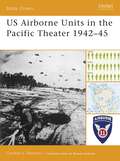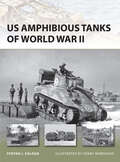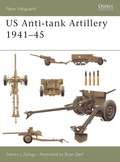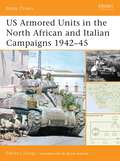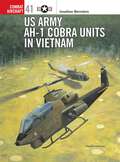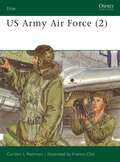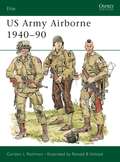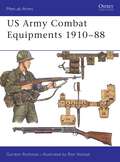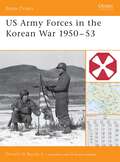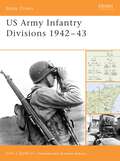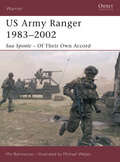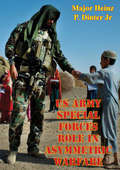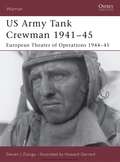- Table View
- List View
US Airborne Units in the Mediterranean Theater 1942-44
by Gordon RottmanThis book is the first of three to examine the genesis, organization and operational deployment of the US airborne divisions in World War II. It discusses early airborne units, detailing how and why they were formed. Task organization for combat, details of attached units, tactics, and weapons and equipment are examined, together with command relationships. The units discussed in this book include the 82d Airborne Division, 1st Special Service Force, 517th Parachute Regimental Combat Team and 1st Airborne Task Force, and the operations in North Africa, Sicily, the Italian mainland, and in southern France are covered.
US Airborne Units in the Pacific Theater 1942-45
by Gordon RottmanThe US airborne units serving in the Pacific Theater during World War II are considered to be among the best-trained and effective forces in the war. Deployed in fewer numbers than was the case across Europe, parachute units such as the famed 11th Airborne Division and the 503rd Parachute Infantry Regiment operated in harsh terrain, over long distances against a determined enemy in the most extreme situations. These parachute regiments were involved in some of the most significant combat situations in the Pacific, recapturing Corregidor Island, invading the Aleutians and the first troops to arrive in Japan before its surrender. Using detailed maps, an array of photographs and color artwork and organizational tables, Gordon Rottman describes the internal organization, unique weaponry and equipment, training and combat operations of these elite units, highlighting unusual aspects of their service record and the difficulties of dropping onto tiny islands surrounded by freezing seas, completing the Battle Orders examination of the organization and operational deployment of all the US airborne units that fought in the war.
US Amphibious Tanks of World War II
by Steven Zaloga Henry MorsheadThe advent of combined arms operations in World War II created the need for specialized armored vehicles. In the case of amphibious attacks, the issue arose of how best to land tanks on a beach. Although a variety of specialized landing craft were developed, the Dieppe raid in 1942 encouraged the development of tanks that could be deployed from further off-shore to limit the vulnerability of the LCT craft. The deep-wading equipment that they developed was first used during Operation Husky on Sicily in July 1943, and subsequently for Operations Avalanche (Salerno, September 1943), Shingle (Anzio, January 1944) and Overlord (Normandy, June 1944). The US-manufactured DD tanks were used during Overlord by both US and British forces, and again in 1945 during the Rhine crossings. Initially, developments in the Pacific Theater were separate from those in Europe. The Marines learned from the Tarawa landings in 1943 that unprepared tanks could not be safely landed even in shallow water. DD tanks were never seriously considered for the Pacific, so other solutions were sought. A detailed study of specialized US amphibious tanks, this is a title that will appeal to those interested in both Pacific and European Theaters, modellers and collectors.
US Anti-tank Artillery 1941-45
by Steven Zaloga Brian DelfThe US Army's development of the 37mm anti-tank gun began in response to needs identified during the Spanish Civil War. By the time it entered service in Tunisia in 1943, the gun was already obsolete, and the US began the licensed manufacture of the British 6-pdr in the hope of finding a quick solution to its artillery requirements. This in turn proved unequal to the demands of warfare in France in 1944, and further anti-tank measures were developed - rocket propelled grenades for infantry use, and weapons designed specifically for use by the Tank Destroyer Force.
US Armed Forces in China 1856-1941
by Mike Chappell John LangellierThis volume reveals the little-known story of the 90-year presence of American forces in China until the fall of Peking in 1941. Included is coverage of the first operations on the Pearl River in 1856 as well as US involvement in the Boxer Rebellion of 1900. As China entered a chaotic period in her history, known as the years of the "Warlords," American marines also participated in numerous small-scale amphibious landings. Finally, during the later Sino-Japanese War (1937-1945) and early into World War II (1939-1945), US volunteers of the "Flying Tigers" became renowned for their combat missions in support of Chinese Nationalist forces, and their aerial duels are also recounted by the author John P. Langellier, who has spent several years researching the subject in the US and China. Discover the history of these various actions and the different services involved, recreated in color artwork and illustrated with rare, previously unpublished photographs.
US Armored Divisions
by Steven ZalogaThe armored divisions were the shock force of the US Army's combat formations during the fighting in Northwest Europe in the final year of the war. Of the 16 such divisions formed during the war, all but one served in the European Theater of Operations. This book examines the organizational structure, operational doctrine and combat mission of these divisions from D-Day onwards, describing how doctrines and tactics were changed as the divisions were forced to adapt to the battlefield realities of combat against an experienced foe. The lessons drawn by the armored divisions from the bitter fighting in Northwest Europe from 1944 to 1945 strongly shaped postwar US Army doctrine.
US Armored Units in the North African and Italian Campaigns 1942-45
by Steven ZalogaThe Mediterranean Theater of Operations (MTO) saw the first operational deployment of US armoured divisions in World War II, and the experience proved chastening for the 1st Armored Division when it suffered defeat at the hands of Rommel's Afrika Korps at the battle of Kasserine Pass. This title covers the organization of these early US armored divisions, as well as the independent tank and tank destroyer battalions that accompanied them. It details the evolution of US armoured warfare tactics and doctrine, learned from the difficult experiences of North Africa, and illustrates how they were used elsewhere in the Mediterranean, particularly in the Italian Peninsula.
US Army AH-1 Cobra Units in Vietnam
by Jim Laurier Jonathan BernsteinOsprey's study of AH-1 helicopters and their participation in the Vietnam War (1955-1975). Bell's AH-1 Cobra was the first dedicated helicopter gunship to reach frontline service anywhere in the world. Developed as a private venture by the manufacturer, and based on the mechanics of the ubiquitous UH-1 Huey, the Cobra proved a huge success once introduced into combat with the US Army in 1966. Built as a key weapon in the Advanced Aerial Fire Support System concept of 1965, the AH-1 was one of the few aircraft to reach the combat zone after actual combat experience went into its design. The AH-1 helped reduce the losses being suffered by vulnerable troop transport helicopters by providing effective fire suppression during airmobile operations. This book explores its history, technology and crew.
US Army Air Force
by Gordon Rottman Francis ChinWhile the most conspicuous components of the US Army Air Forces in World War II (1939-1945) were the air units, there were also hundreds of ground units and organisations. Besides assigned military personnel the AAF also employed thousands of civilians. Many unique outfits were designed to meet the AAF's special needs. Uniformed civilians also possessed a variety of unique uniforms and insignia. These general issue and specific uniforms are the subject of this volume by one of Osprey's most experienced authors, Gordon L. Rottman, whose detailed text is backed by plenty of contemporary photographs and 12 full page colour plates by Francis Chin.
US Army Airborne 1940-90
by Gordon Rottman Ronald VolstadOsprey's examination of the US Army's airborne division in various conflicts, such as World War II (1939-1945) and the Vietnam War (1955-1975). The first 50 years of the US Army airborne arm is a story of continuing battles with the nation's enemies, of battles within the Army's hierarchy, of change, and of adaptation. If there is any single attribute the airborne soldier can claim as his most sterling, it is his uncanny ability to adapt - his flexibility. The very nature of a paratrooper demands this ability to adapt. The motivation and ésprit de corps it develops within these units is something not to be taken lightly. The first class pairing of Gordon L. Rottman and Ron Volstad bring to life the history of these remarkable troops.
US Army Alphabet Book
by Jerry Pallotta Sammie GarnettTake a look at fascinating facts about the US Army--one for each letter of the alphabet! There's a lot to learn about this important branch of our armed forces.With facts from both history and the modern era, each letter covers something Army related. From the cavalry and jeeps to reserves and special forces, this book is a wealth of information that highlights the courage and commitment it takes to serve in the US Army.
US Army Combat Equipments 1910-88
by Gordon Rottman Ronald VolstadWhether referred to as web gear, TE-21, TA50, LBE or LCE, the American soldier's individual combat equipment was seldom praised - except by its developers. Nevertheless, it has always been, and will continue to be an essential part of the fighting man's burden. With the aid of plenty of contemporary photographs, diagrams, and eight full page colour plates by Osprey veteran Ron Volstad, Gordon Rottman's text unearths a wealth of information on the changing nature of US combat equipments from 1910-1988.
US Army Forces in the Korean War 1950-53
by Donald BooseWhen North Korea attacked the South on June 25, 1950, United States forces in East Asia were under the command of General Douglas MacArthur, whose largest ground force was Eighth US Army. This army fought a tenacious defense of South Korea, counterattacked north to the Yalu River with the separate X Corps, before falling back in the face of massive Chinese intervention, conducted a war of movement, and settled into a bloody two-year long period of static warfare. This title examines the combat mission, organization, and evolution of the Eighth US Army in Korea and its 300,000 US ground forces through highly detailed orders of battle, tables of organization and equipment, and examinations of crucial aspects such as doctrine, training, and tactics.
US Army Infantry Divisions 1944-45
by John SayenA complete overview of the evolving organization, tactics, doctrine, weapons and equipment of the US Infantry in the Pacific, Mediterranean and European theatres, from 1944 to the war's end. This follow-up to Battle Orders 17: US Army Infantry Divisions 1942-43, covers the critical period 1944-45 when changes instituted by Lieutenant General Leslie J McNair, the head of the Army Ground Forces and an organizational genius, were imposed on an army reluctant to change. The book includes a table outlining all 66 US Infantry Army divisions that served during World War II, and analyzes the organization of manpower and resources that turned these divisions into a war-winning army.
US Army Infantry Divisions 19420-43
by John SayenThe US Army infantry division was an intricate system of men and equipment welded together by doctrine and organization into an entity that could fight, maneuver, communicate within itself as well as with outside entities, and regenerate itself through a supply and replacement system. This book examines the organizational development, mobilization, deployment and combat actions of World War II US Army infantry divisions up until the end of 1943. Among the units covered are the separate infantry regiments and battalions of the standard type, showing how the Army's new triangular infantry division (based on three infantry regiments) evolved from the earlier square division (based on four).
US Army Infantryman in Vietnam 1965-73
by Gordon Rottman Kevin LylesThis book tells the compelling story of the average US infantryman in the Vietnam War (1955-1975). Beginning with conscription, enlistment, Basic Training, and Advanced Individual Training at the Armed Forces Induction Center at Fort Polk (the infamous "Tigerland"), it goes on to explore the day-to-day realities of service in Vietnam, from routine tasks at the firebase to search-and-destroy missions, rocket attacks, and firefights in the field. Weaponry, clothing, and equipment are all described and shown in detailed color plates. A vivid picture of the unique culture and experiences of these soldiers emerges - from their vernacular to the prospect of returning to an indifferent, if not hostile, homeland.
US Army Long-Range Patrol Scout in Vietnam 1965-71
by Adam Hook Gordon RottmanOsprey's survey of the Long-Range Patrol Scouts of the US Army during the Vietnam War (1955-1975). The Vietnamese knew the Long-Range Patrol Scouts as "the men with green faces," a reference to the camouflage paint that they used. Operating in patrols of four to six men these men were like ghosts, operating well behind enemy lines and fighting in the shadows. In the rough, inhospitable jungle war these Scouts became invaluable assets. They did not engage the enemy, rather they became the Free World's eyes on the ground, spying out enemy positions and movements before calling in strikes to eliminate them. This book examines the Long-Range Patrol Scout's superior stealth movement techniques, camouflage and concealment, tracking, counter-tracking, observation, and other fieldcraft skills. It also examines the occasions they participated in small scale direct actions including ambushes and small scale raids. Written by a Special Forces' Veteran who fought in Vietnam, and packed with rare photographs and full-color artwork this book not only provides an insight into the remarkable lives of these scouts when on campaign, but also details the training and conditioning that it took to become a shadow warrior.
US Army Paratrooper in the Pacific Theater, 1943-45
by Gordon RottmanThe two major Army units that operated in the Pacific - the 11th Airborne Division and the 503rd Parachute Regimental Combat Team (PRCT) launched small-scale operations on extremely difficult, if not, outright dangerous, terrain, while also conducting amphibious assaults, fighting on jungled hills, swamps and mud. The two units were very different, with the 503rd PRCT being reserved for special purpose missions and the 11th Airborne Division occupying a more traditional role. This title will deal with the background to these two units and their training, before detailing the specific equipment used in the theatre and, finally and most importantly, the combat experience at a personal level of the US Army Paratrooper in the Pacific.
US Army Ranger 1983-2002
by Mir Bahmanyar Michael WelplyThis study of the US Army Ranger takes the reader through the distinct stages of training and acceptance, including the Ranger Indoctrination Program and Ranger Battalion training, and details the developments in Ranger weaponry, equipment and clothing since the early 1980s. Using first hand accounts, it shows what it was like to fight in Panama in 1989, in raid missions in Iraq in 1991 and Somalia in 1993, and brings the unit up to date with the 3rd Battalion's deployment to Afghanistan in Operation Enduring Freedom. It also covers the culture of the Rangers, from their special language and terminology, to the rites of passage that lie behind the formal training program.
US Army Rangers & LRRP Units 1942-87
by Gordon Rottman Ronald VolstadRanger - the very word conjures up visions of small, highly trained units executing lightning-fast raids on an unexpecting enemy. It is also synonymous with high esprit de corps and excellence at arms. The US Army Rangers provide units of well-disciplined soldiers who possess the knowledge and courage to operate on their own, deep behind enemy lines. Gordon L. Rottman explores the history of these unique troops, starting with the original 'Rogers' Rangers' company of 1756, whose daring operations and deep penetrations of enemy-held country laid down the pattern for all subsequent Ranger units to follow.
US Army Soldier
by Howard Gerrard Kenneth EstesOsprey's survey of US Army soldiers' participation in the war in Iraq. In April 2003, after a month of heavy bombardment, Baghdad fell under coalition forces' control. The forces established the Coalition Provisional Authority and in the heart of the city, an 8km square mile "Green Zone" was formed to maintain order until the new Iraqi government became a reality.This title focuses on the lives of those soldiers whose task it was to bring stability to the area, primarily recounting the experiences of Task Force 1st Armored Division (TF 1AD) ("Old Ironsides"). The division's first operation, dubbed Iron Dig, was intended to verify the death of Saddam Hussein by finding his remains in a bombed restaurant in Baghdad. This was the first of many operations that combined combat and intelligence skills in attempts to capture or kill significant numbers of former regime leaders that were thought to be responsible for the remainder of attacks on coalition forces. This unique theater of operations severely tested the troops on many levels, both personally and professionally, as not only did they have to deal with living and fighting in extremely high temperatures, poor standards of living, and little respite, but also their operations became the center stage of a controversial debate surrounding the occupation.Discussed are the soldiers' personal experiences from recruitment, specialist training, and weaponry; to the aftermath and effects that the conflict had on them. The author, Ken Estes, uses interviews and recently declassified material to offer a full and accurate insight into this controversial theater of war.
US Army Special Forces 1952-84
by Gordon Rottman Ronald VolstadFrom its very inception the United States Army Special Forces has been enmeshed in controversy, its mission misunderstood to varying degrees, and its very existence opposed by some of the Army hierarchy. Nevertheless it continues to serve in a highly specialised role in all manner of differing conditions. There can be few better qualified to chronicle the history of this unique organisation than former Special Forces Group weapons specialist Gordon Rottman, whose expert knowledge is clearly evident in this authoritative text. This volume also contains 12 full page colour plates by one of the world's most respected military artists, Ron Volstad.
US Army Special Forces Role In Asymmetric Warfare
by Major Heinz P. Dinter Jr.The U.S. National Security Strategy is the basis of a preventive solution through global engagement, which fosters international interoperability and cooperation to defeat complex asymmetric threats. The study examined how U.S. Army Special Forces (SF) can advance this interoperability and cooperation, and identified three evolving roles; Strike Force, Warrior Diplomats, and Global Scouts. As they transition into the 21st century, the central research question is: will U.S. Army Special Forces need to redefine themselves in terms of mission, doctrine, training, or organization as a result of their evolving roles conditioned by an asymmetric threat environment?The study examined the relevance of core, collateral, and emerging missions. It concluded that basic SF doctrine remains sound, but the changing environment and evolving roles of SF will call for a certain amount of refinement. Tactics, techniques, and procedures will change as new technologies are introduced into SF organizations, but emphasis on the human element remains essential, and SF core competencies and warrior skills must be preserved.The study concluded with recommendations to preserve the relevance and efficiency of SF as the premier mechanism for extending U.S. influence in a world of increased global interaction, required to meet security needs.
US Army Tank Crewman 1941-45: European Theater of Operations (ETO) 1944-45
by Steven Zaloga Howard GerrardRevealing what it was like to live and fight in a medium tank during World War II (1939-1945), this book is structured around the career of a single tanker from 37th Tank Battalion, 4th Armored Division. The focus is largely on the crew of an M4 Sherman, though light tank service is also studied. Tank operation required a well- trained and well-coordinated crew. The crew positions and roles of tank commander, gunner, driver, loader, and assistant driver are all covered in detail, together with recruitment procedure, specialist training, and the variety of specialized clothing and personal weaponry.
US Army and Marine Corps MRAPs
by Henry Morshead Mike GuardiaDeployed to Iraq and Afghanistan, the newest land warfare system in the United States Army and Marine Corps, the Mine Resistant Ambush Protected (MRAP) vehicle has undeniably proved its value. Designed to meet the challenges of operating in a counterinsurgency environment, the MRAP has taken survivability to a new level. MRAPs are currently manufactured by three companies: BAE Systems, Navistar International Military Group, and Force Protection Inc. Each company manufactures an MRAP according to one of three classifications set by the US Department of Defense: Category I, Category II, or Category III. The Category I MRAPs are designed for urban combat. Category II covers the MRAPs designed for convoy security, medical evacuation, and explosive ordnance disposal. The Category III MRAP performs the same function as Category II but is designed to carry more personnel.Since their introduction in 2007, MRAPs have performed remarkably in the asymmetric warfare environment. Their unique design and survivability characteristics have saved the lives hundreds of soldiers who otherwise would have been lost to landmines or IED attacks. As with any combat system, however, the MRAP is not without its drawbacks.

